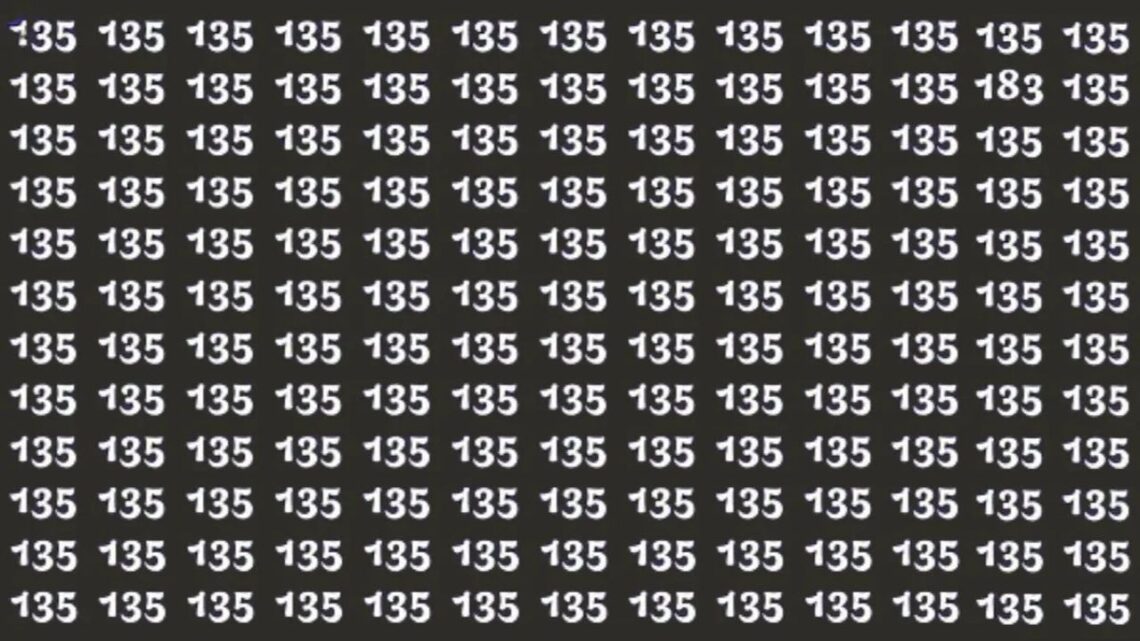The viral visual puzzle hides the number “183” inside a dense grid packed with look-alike strings such as “135”.
Your goal is simple: spot 183 in 5 seconds. Many posts claim only 3% of people can do it, especially those with 20/20 vision.
Treat that percentage as a fun challenge rather than a scientific measurement—it’s a quick attentional test that rewards speed, pattern recognition, and attention to detail.
Why The Puzzle Feels So Hard
- Distractor Similarity: “183” and “135” share the same digits, so your brain must notice small position changes under time pressure.
- Set-Size Effect: A bigger grid means more items to scan, which naturally slows you down.
- Time Pressure: The 5-second limit increases cognitive load, making tiny differences easier to miss.
- Eye-Movement Cost: Every extra fixation or back-and-forth glance adds milliseconds that quickly eat up the clock.
How To Spot “183” Faster
- Search For The “8” First: The “8” has a rounded, closed-loop shape that stands out. After you see an 8, quickly check for 1 before it and 3 after it to confirm “183.”
- Scan In Blocks: Divide the grid into small clusters (for example, 4×4 or 5×5). This reduces aimless eye movements and keeps your scan path tight.
- Use A Zigzag Route: Sweep left-to-right on one row, then right-to-left on the next. This avoids wasted time returning to the start of each line.
- Keep A Rhythm: Don’t fixate too long on one spot. If a cluster looks uniform, move on and come back only if needed.
- Prime Your Brain: Before the timer starts, visualize “1-8-3”. Priming strengthens the pattern you’re looking for and can speed up recognition.
Does 20/20 Vision Guarantee Success?
No. 20/20 vision measures clarity at distance, not your processing speed, selective attention, or visual search strategy.
You can have excellent acuity and still miss “183” if your scan path is inefficient or you freeze under the timer.
Conversely, with practice and a strong tactic (like anchoring on the 8), many people can beat the 5-second mark.
Common Mistakes To Avoid
- Tunnel Vision: Staring at one area too long wastes precious time.
- Digit-By-Digit Reading: Reading every string slows you down; treat the grid as shapes and textures first.
- Skipping Corners: Corners and edges are often ignored—don’t neglect them.
- Confirmation Delay: If you spot an 8, verify quickly; don’t second-guess for too long.
Puzzle Facts At A Glance
| Item | Details |
|---|---|
| Target | 183 hidden among many 135 strings |
| Time Limit | 5 seconds (most shared versions) |
| Claimed Success Rate | “Only 3%” (a playful, viral claim) |
| Skills Involved | Visual search, pattern recognition, attention to detail, processing speed |
| Best Strategy | Anchor on the “8,” then confirm 1 before and 3 after |
| Practice Tip | Train with grid puzzles using similar-looking digits |
Who Should Try This Puzzle?
- Students looking to sharpen focus and pattern spotting for exams and logic tests.
- Gamers who want faster target acquisition and situational awareness.
- Professionals in detail-heavy work (editing, data checks, quality control) who benefit from quicker visual scanning.
The “spot 183 in 5 seconds” challenge is a smart blend of speed, design, and psychology. Even with 20/20 vision, success hinges on strategy, not just eyesight.
Use the 8-first method, scan in blocks, and keep a steady rhythm. With a bit of practice, you’ll beat the timer, boost your visual search skills, and prove that you’re well above the playful “3%” threshold.
FAQs
Is this a real intelligence or eyesight test?
No. It’s a fun visual challenge. It trains attention and search strategy, but it’s not a clinical test of IQ or eyesight.
How can I consistently beat 5 seconds?
Practice a two-step routine: scan for 8s first, then confirm 1 and 3 around it. Keep your scan path zigzag, and work in blocks to stay efficient.
Why do I see “135” when it’s actually “183”?
Under pressure, your brain fills gaps and expects familiar patterns. The digits are similar, so pattern expectation can override what’s truly there.
